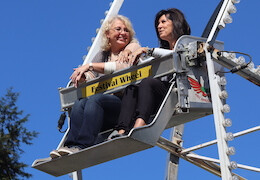COVID-19 has brought us to an uncertain place.
Many people find themselves in unfamiliar territory. We may be working from home instead of the office. We may be teaching children who are no longer in school. We may be students or teachers navigating our way through online classes. We may be grandparents missing the physical closeness of our children and grandchildren.
Uncertainty ushers anxiety and fear into the theater of our mind to sit beside us while our eyes are glued to the screen.
We feel trapped.
But we do not have to remain in that place.
There are tools to help us move to a better place. We are familiar with them – prayer, scripture and devotionals, walks, conversations with a friend, the off-switch on our TV, or the power button on our electronic devices. These are options that may not be so familiar to us. Let’s take a look at some of those.
Be Mindful
As anachronistic as it sounds, I carry a pocket watch. It is almost 50 years old. Every morning before I leave the house, I pick up the watch, click it open, and slowly wind it. That short 30 seconds of holding this gift from my parents and winding it prepares me for my day. All the rush of the morning and the anticipation of the day stops, and I am completely mindful of this one act.
Find something that you can do every day that helps you forget everything else except one simple thought. Like putting on a favorite sweatshirt, it will bring you comfort.
Breathe
Duh! Sounds funny doesn’t it? Anxiety causes our body to tense up. When that happens our breathing can become shallow, restricted, and erratic. Practicing a breathing technique can restore rhythm and order to our body.
A popular technique is the 4-7-8 breathing method. Find a comfortable position. Breathe in through your nose for 4 counts. Hold your breath for 7 counts. Then exhale through your lips for 8 counts. Then, try it again. That’s it. Just do it twice. This method helps to relax our body and bring our breathing back to a natural rhythm.
Create a Calming Place
Hectic days often cause messy ways, and a cluttered mess makes most of us feel out-of-sorts. What is it that brings calm to you? Is it a neat flower bed, a clean dining room table, a shiny car, or a well-made bed? Decide what that one thing is, and make sure it stays that way. That one calming place can bring a lot of peace to our chaotic lives.
Meditate
I’m not talking about the cartoonish idea of sitting cross-legged and humming. I am talking about the intentional act of quieting all the chatter going on in our minds.
Let me suggest a few ways to do this. For all of these, find a quiet place and a relaxed position.
One is referred to as the monkey and the ox. Think of the monkey who chatters and swings wildly through the jungle canopy. Now think of the quiet, steady ox that is slowly, determinedly walking to its destination. Visualize the monkey as representative of your chattering thoughts. See on the jungle floor the slow walk of the quiet ox. Watch the monkey become exhausted and take a ride on the back of the ox. Another exercise is to think of a drop of water falling into a basin of water. See the plop of impact. Watch the ripples on the surface move to the edge and dissipate. See? You feel better already just reading about it.
Read a Psalm of Lament
Often, we think of the Book of Psalms as being hymns of praise and rejoicing. But there is a category of psalms that expresses lament. We don’t do lament very well. We seem to be better at complaining. A lament has a purpose. Complaining does not. A lament expresses sorrow, failure, disappointment, and loss, but it also articulates the power, salvation, and love of God. A psalm of lament is cathartic and healing. Here is a week’s worth of laments from the psalms – 3, 12, 22, 44, 57, 80, 86. If you really want to enhance this, FaceTime a friend and read one together.
God has created us to be communal people. The ancient practice of looking upward, inward, and outward is a great reminder that we can get through this together.








